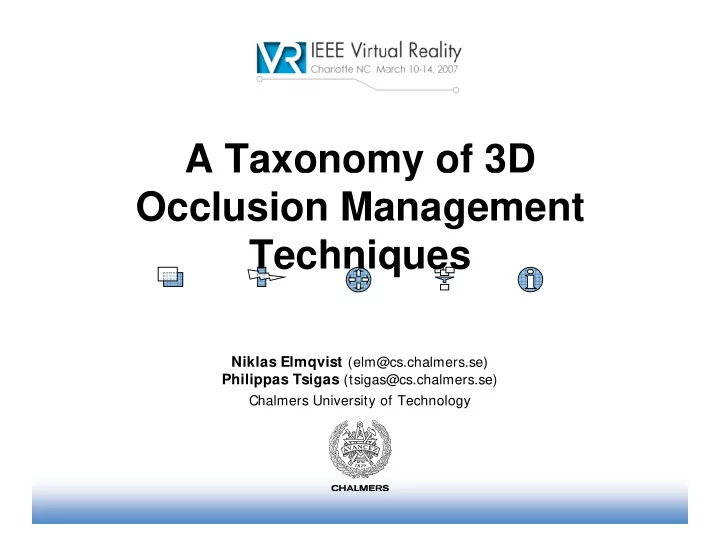

A Taxonomy of 3D y Occlusion Management T Techniques h i Niklas Elmqvist (elm@cs.chalmers.se) Philippas Tsigas (tsigas@cs.chalmers.se) Philippas Tsigas (tsigas@cs.chalmers.se) Chalmers University of Technology
A Common Denominator… Where is the target? 3D occlusion is a big problem! March 15, 2007 2
Why a Taxonomy? • Occlusion is a fact of life in 3D • Visualization designers (us) deal with it routinely – X-ray vision, bird’s eye views, World-in-Miniature, etc… – Occlusion management techniques (most often 3D) l i h ( f ) But how ? Motivation? Strategies? • • • Formalizing occlusion and occlusion management Formalizing occlusion and occlusion management – Provide common vocabulary – Facilitate comparison and benchmarking – Suggest suitable methods – Inform future research March 15, 2007 3
Taxonomy Design • What goes in a taxonomy? g y Use as a design space as well as for classification • • Characteristics of occlusion management techniques? • Six primary dimensions: – Primary Purpose – Disambiguation Strength Disambiguation Strength – Depth Cues – View Paradigm – Interaction Model – Target Invariances March 15, 2007 4
Taxonomy Dimensions (1) • Primary Purpose y p • Disambiguation Strength g g • Why do we need this • What can the technique technique? handle? • Domain: [ discovery, • Domain: [ proximity, access, spatial relation ] intersection, enclosement, containment ] containment ] March 15, 2007 5
Taxonomy Dimensions (2) • Depth Cues p • View Paradigm g • How much depth • How are the views and view information is retained? space managed? • Domain: [ low to high ] • Domain: [ single/twin/multiple x int/sep ] March 15, 2007 6
Taxonomy Dimensions (3) • I nteraction Model • Target I nvariances g • How do users actually • What is the visual impact activate the technique? of the technique? • Domain: [ active, passive, • Domain: yes/no for hybrid ] [ location, geometry, appearance ] appearance ] March 15, 2007 7
8 Classification March 15, 2007
Design Patterns • Analyze classifications of 25+ techniques y q Related trends crystallize – extract design patterns • • Design pattern: [Alexander 1976] – Generic and reusable solution to a commonly occurring problem March 15, 2007 9
Multiple Views • Provide additional 3D views to reduce occlusion • Characteristic techniques : – CAD programs – Worlds in Miniature [Stoakley et al. 1995] ld – Worldlets [Elvins et al. 1997] March 15, 2007 10
Virtual X-Ray • Make interfering surfaces (semi-)transparent to show g ( ) p hidden targets • Characteristic techniques : – Perspective cutouts [Coffin and Höllerer 2006] – Interactive break-away [Diepstraten et al. 2003] – IDVR [Viola et al. 2004] March 15, 2007 11
Interactive Exploder Interactively displace objects � separating targets or • y p j p g g removing distractors • Characteristic techniques : – 3D explosion probe [Sonnet et al. 2004] l b – Deformation-based volume explosion [McGuffin et al. 2003] – BalloonProbe [Elmqvist and Tudoreanu 2006] March 15, 2007 12
Projection Distorter • Integrate several 3D views into a single one in the view g g (projection) space • Characteristic techniques : – Artistic multiprojection [Agrawala et al. 2000] l – View projection animation [Elmqvist and Tsigas 2006] – Non-linear view projections [Singh 2002] March 15, 2007 13
Tour Planner Build and take user on a grand tour that reveals the g • whole 3D world • Characteristic techniques : – Way-finder [Andújar et al. 2004] f d – Guided Web3D worlds [Chittaro et al. 2003] – Dog-on-a-leash [Wernert and Hanson 1999] March 15, 2007 14
The Future? • Patterns extracted from existing work g – Not complete, other patterns possible! – Example: scene index, view management, cutting planes • F t Future research directions h di ti – Combinations of patterns – Awareness – Previous interaction to inform target selection [Singh and Balakrishnan 2004] • • Additional perceptual mechanisms Additional perceptual mechanisms – Augmented perception… March 15, 2007 15
Conclusions • Taxonomy for occlusion management y g – Classifying existing work and extract patterns – Suggest future research directions • Strategy space distinguishing factor: St t di ti i hi f t – I mage space : virtual X-ray – View space : projection distorter and multiple viewports – Object space : interactive exploder – Temporal space : tour planner • • Future: combinations awareness and hybrid interaction Future: combinations, awareness and hybrid interaction – More patterns? March 15, 2007 16
Questions? Current Contact I nformation: • Niklas Elmqvist INRIA Futurs/LRI Université Paris-Sud XI Université Paris-Sud XI elm@lri.fr • Philippas Tsigas Department of Computer Science Chalmers University tsigas@cs.chalmers.se tsigas@cs.chalmers.se http:/ / www.cs.chalmers.se/ ~ elm/ projects/ phd-thesis/ http:/ / www.cs.chalmers.se/ elm/ projects/ phd thesis/ March 15, 2007 17
Recommend
More recommend